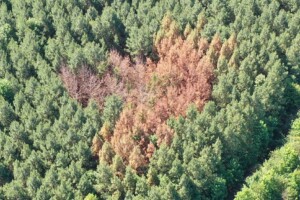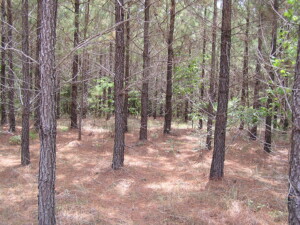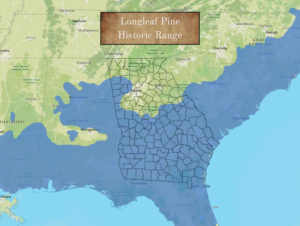

The Southern Pine Beetle (SPB), Dendroctonus frontalis, is not much bigger than an eye gnat (Figure 1). It attacks and kills all species of southern yellow pines in Georgia, including white pines. Trees are killed when beetles construct winding S-shaped egg galleries underneath the bark (Figure 2). These galleries effectively girdle the tree and destroy the conductive tissues that transport food throughout the tree. Furthermore, the beetles carry blue stain fungi on their bodies that clog the water conductive tissues (xylem) that transport water within the tree. Signs of attack on the outside of the tree include pitch tubes and boring dust, known as frass, caused by beetles entering the tree (Figures 3 & 4).



Needles turn pale green to yellow to red, then brown (Figure 5). Trees under drought stress may not produce pitch tubes when attacked by southern pine beetles, and that is why the other signs are important for identifying infested trees.
The southern pine beetle is the most destructive forest insect in the southeastern United States. Southern pine beetles have killed over $254 million worth of pine trees in Georgia since 1972. Based on more than 35 years of aerial survey data in Georgia, SPB outbreaks tend to be cyclic and often correspond with weather events of drought or flooding, depending on the location within Georgia. The data further suggests that Piedmont populations increase to epidemic levels every six to 10 years, while those in the Mountain region occur every 12 years, with both being influenced by drought. Outbreaks occurring in the Coastal Plain are more sporadic and can be triggered by flooding or drought. Outbreaks may persist for one to three years.
Pines are most susceptible when they are stressed by drought, flooding, storm damage, or by stand conditions such as overcrowding, old age, or root disease. Lightning struck trees are particularly vulnerable to attack, as are trees damaged by road building or logging activities (Figure 6).

All of the above factors help sustain beetles when their numbers are low. However, during epidemic years when SPB numbers are skyrocketing, even the healthiest of trees/stands are killed. Therefore, foresters need to conduct practices that promote tree vigor while SPB populations are low. This is best achieved by thinning overcrowded pine stands to reduce competition between trees. Certain pathogens that lead to diseases, such as pitch canker, littleleaf disease and other root diseases, can weaken pines and create stands that are especially vulnerable to SPB attack and damage. Selecting pine species that are less susceptible to SPB is another key to preventing outbreaks. Loblolly, shortleaf and Virginia pines are the three most susceptible species, with white, slash and longleaf pines being the most resistant.
Suppression
Forest managers and landowners faced with southern pine beetle infestations can choose from two direct control options: (1) cut and remove (can include other areas for thinning or harvest if necessary) or (2) cut and leave (can include piling and burning if necessary). Both options must include cutting a buffer of trees that aren’t infested around the leading-edge of the active infestation. Buffer widths should be greater or equal to the height of the infested trees. Chemical control (insecticides) is generally not recommended for suppressing SPB infestations.
Prevention
In cooperation with the US Forest Service, Forest Health Protection Unit, Georgia Forestry Commission participates in three prevention programs: Southern Pine Beetle Prediction Trapping, Aerial Pine Beetle Survey, and the Southern Pine Beetle Prevention and Restoration Cost Share Program.
Every spring, GFC foresters deploy approximately 50 SPB pheromone traps across the state, following USFS protocol. This is part of a program available across the entire range of southern pine beetle, which can now be found all the way to Connecticut.
Aerial Surveys for pine beetles begin in early summer during peak SPB activity. Planes fly in a 5-to-10-mile grid pattern across the state, covering approximately 10 million acres. Detected pine beetle spots are marked by GFC foresters using custom software developed by the USFS. Potential pine beetle spots are then verified on the ground by GFC foresters and forest health specialists. Affected landowners are notified and provide with management recommendations.
The SPB cost share program is available to Georgia landowners who want to reduce their risk of an SPB problem or who need to restore stands killed by SPB. The cost share program helps landowners implement various forestry practices that promote tree health, thus preventing beetle infestations. The program also assists landowners with the restoration of areas killed by SPB. The practices that may be available to landowners are listed below. Click here to apply.

Non-commercial thinning
Dense, over-crowded pine stands need to be thinned to improve the growth of remaining trees and to produce a higher value wood product (Figure 7). A properly thinned stand also reduces the rate at which beetles can spread. Stands should be thinned to a basal area of 80 square feet or less.
Chemical or mechanical release of pine stands
Hardwood species can compete with pines for water and nutrients and should be eliminated if pine vigor is to be maintained. This can be accomplished by the use of selective herbicides.
Prescribed burning

Prescribed burning reduces competing hardwoods and underbrush beneath pines. If done properly, a low intensity fire can improve pine vigor, thus reducing the threat of a SPB infestation (Figure 8).
Pine planting
Planting loblolly, slash, shortleaf and white pine at appropriate stocking levels, and managing these stands at proper densities, can help with vigor and natural resistance to SPB. Matching the correct species to the site is crucial to expect good long-term results. Please contact your GFC forester for help with this important decision.
Hardwood planting
Pine stands that have been killed by SPB can be converted to desirable hardwood plantings. Mast-producing species will improve wildlife habitat for many species of game and non-game animals.
Longleaf pine establishment (in specified areas of Georgia)
Longleaf pine is more resistant to southern pine beetle attack. Landowners should consider planting longleaf pine instead of loblolly within its natural range (Figure 9).

Southern Pine Beetle in Georgia
Pine Bark Beetles in Urban Areas
Georgia 2024 SPB Prediction Trapping Results
Georgia 2022 SPB Aerial Survey Report
Southern Pine Beetle Information Center
USFS Southern Pine Beetle Program
USFS Southern Pine Beetle Prevention Program
